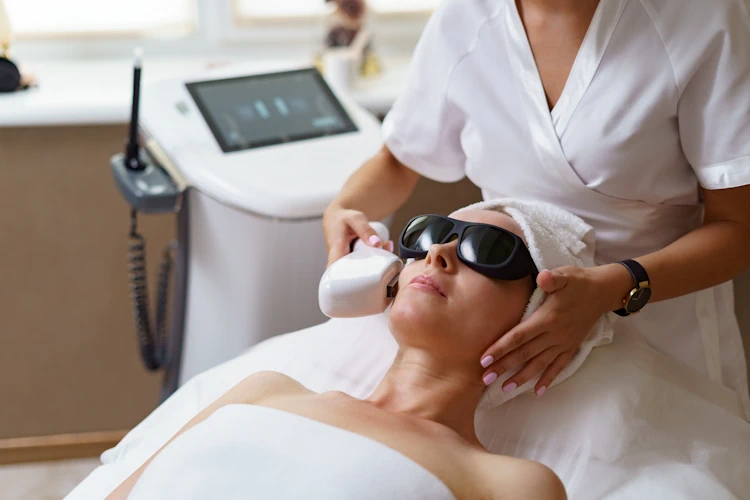
Lighting the Way: Exploring Different Laser Approaches to Pigmentation Removal
Pigmentation issues such as sunspots, age spots, and melasma can affect the appearance of the skin and impact one’s confidence. In the quest for clearer and more even skin, laser technology has emerged as a powerful tool for pigmentation removal. This article delves into the various laser pigmentation removal approaches used for pigmentation removal or “menghilangkan jeragat“, shedding light on the effectiveness, benefits, and considerations associated with each method.
Understanding Pigmentation Issues
Types of Pigmentation
Sunspots:
- Result from prolonged sun exposure.
- Typically small, dark spots on sun-exposed areas.
Age Spots:
- Common in aging skin.
- Larger than sunspots, with increased pigmentation.
Melasma:
- Hormonally induced pigmentation.
- Appears as brown or gray-brown patches, often on the face.

Q-Switched Nd:YAG Laser
How It Works
- Target: Melanin (pigment in skin).
- Mechanism: Emits short pulses of high-energy light, breaking down melanin particles.
Benefits
- Precision: Targets pigmented cells without affecting surrounding skin.
- Versatility: Effective for various pigmentation issues.
- Minimal Downtime: Generally requires minimal recovery time.
Considerations
- Skin Type: Suitable for a range of skin types, but caution needed for darker skin tones.
- Multiple Sessions: Often requires multiple sessions for optimal results.
Fractional Laser Therapy
How It Works
- Target: Microscopic treatment zones on the skin.
- Mechanism: Creates controlled micro-injuries, stimulating collagen production and replacing pigmented cells.
Benefits
- Collagen Stimulation: Addresses both pigmentation and skin texture.
- Customizable: Adjustable intensity for varying skin concerns.
- Reduced Downtime: Fractional approach minimizes recovery time.
Considerations
- Sun Sensitivity: Increased sensitivity post-treatment, necessitating sun protection.
- Potential Redness: Temporary redness and swelling may occur.
Ruby Laser
How It Works
- Target: Melanin in pigmented cells.
- Mechanism: Emits red light absorbed by melanin, causing photothermal destruction.
Benefits
- Specific Targeting: Precise targeting of pigmented cells.
- Predictable Results: Known for consistent and predictable outcomes.
- Minimal Side Effects: Generally well-tolerated with minimal side effects.
Considerations
- Pain Level: May cause discomfort during the procedure.
- Limited Applicability: Less effective for certain pigmentation types.
Picosecond Laser
How It Works
- Target: Pigmented cells which known as pigmentation removal.
- Mechanism: Delivers ultra-short pulses in picoseconds, breaking down pigment more efficiently.
Benefits
- Enhanced Efficiency: Faster and more efficient pigment removal.
- Reduced Heat: Minimizes heat-related damage to surrounding tissues.
- Versatile: Effective for various pigmentation issues.
Considerations
- Cost: Generally more expensive than other laser treatments.
- Professional Skill: Requires expertise for optimal results.
Combination Approaches
Hybrid Laser Treatments
- Combining Technologies: Some clinics use a combination of lasers for a comprehensive approach.
- Tailored Solutions: Allows for personalized treatment plans addressing multiple concerns simultaneously.
Benefits
- Optimized Results: Enhanced outcomes by targeting pigmentation through different mechanisms.
- Customizable: Tailored to individual skin types and concerns.
Considerations
- Cost: Combination treatments may be more expensive.
- Consultation Importance: Requires a thorough consultation with a qualified professional.
Conclusion
Laser approaches to pigmentation removal offer a diverse range of options catering to different skin types, concerns, and preferences. Whether opting for the precision of Q-switched Nd:YAG, the controlled micro-injuries of fractional laser therapy, the specific targeting of the ruby laser, or the enhanced efficiency of picosecond lasers, individuals can find a solution tailored to their unique needs. The emergence of combination approaches further underscores the customizable nature of modern pigmentation removal treatments. As technology continues to advance, the future holds even more promise for individuals seeking effective and safe solutions to pigmentation concerns.
FAQs
- How many sessions are typically required for laser pigmentation removal?
- The number of sessions varies based on the type and severity of pigmentation. Multiple sessions are common, and a qualified professional can provide a personalized treatment plan.
- Is laser pigmentation removal suitable for all skin types?
- While many lasers are suitable for a range of skin types, some may carry risks for individuals with darker skin tones. A thorough consultation with a dermatologist or laser specialist is crucial.
- Are laser pigmentation removal treatments painful?
- The level of discomfort varies depending on the laser type and individual pain tolerance. Some treatments may cause mild discomfort, while others may involve a more intense sensation. Topical anesthetics can be used to manage pain.
- Can laser pigmentation removal treatments be combined with other cosmetic procedures?
- Yes, combination treatments are common. Many individuals opt for a comprehensive approach, addressing pigmentation concerns alongside other skin issues, such as wrinkles or texture irregularities.
- Is there a risk of pigmentation recurrence after laser treatments?
- While laser treatments can effectively reduce pigmentation, the risk of recurrence exists, especially with sun exposure. Sun protection and proper skincare post-treatment are crucial for maintaining results.

